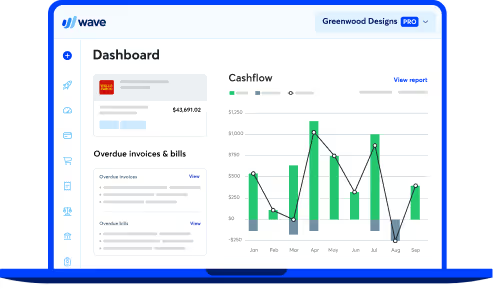
Social media marketing for small businesses
Crafting your social media marketing strategy
We’ll talk about the four big social networks (Facebook, Twitter, Instagram, and LinkedIn) but there are tons of additional niche social platforms you can leverage. That’s one of the reasons we recommend dipping your toes into social media marketing by tackling one network at a time.
As Sprout Social recommends:
Brands should never take on every social media channel possible in their current marketing strategy. Try to choose the channels that have the most importance based on your brand’s goals.
Understanding the social networks
Before you can dive into putting your social media marketing strategy together, it’s important to understand the different networks, their clientele, and what having a presence on each one could do for your business.
It’s important to note that social networks can (and do!) change and adapt their algorithms over time. The type of content that performs well can change with that algorithm, so it’s vital that you stay up to date on any changes and adjust your social media strategy accordingly.
Facebook is the biggest social media network (by a lot), with over two billion users active using the website at least once a month. As of mid 2018, 1.32 billion of those users are on Facebook every single day.
So who are these billions of people? With the sheer size of Facebook’s reach, most businesses can find some portion of their target market there. Middle age adults (between 35-54 years old) make up the largest age group on Facebook, encompassing more than 30% of users, and women make up just over half (53%) of Facebook users. Typical users have some college education and earn less than $30,000 a year.
Another thing that sets the social networks apart is the type of content that typically performs well on each. Because the audiences and their goals for using each site vary, you can’t simply share the same exact content across all of your business’ social media profiles.
On Facebook, posts that include an image far outperform posts without one. In fact, Facebook posts with images see more than twice as much engagement. So it’s always best to factor images into your Facebook marketing strategy. A few years ago, Facebook launched live video streaming, and it rapidly became a popular way to share on the network. Live videos see users spend as much three times more time watching than traditional videos.
Twitter emerged as the short-form social media platform and initially saw huge growth numbers. With 336 million active users every month, Twitter’s decidedly smaller than Facebook—but 336 million is certainly nothing to shake a stick at!
According to Statista, men make up just over half (53%) of Twitter users, and the largest age group is between the ages of 18-29. However, their user base is a lot more diverse than Facebook, with 18-29 year-olds only making up about 37%. That makes it a good place to target older millennials and young professionals. The average Twitter user is an urban-dweller earning between $50,000 – $75,000.
When it comes to content on Twitter, brevity is the name of the game. Even with the recently expanded 280-character word limit, you still have to keep it short. Twitter’s at its best when it’s fostering real-time engagement. That’s why brief, but timely posts do well there. Because of the character limits, users are more inclined to click through to longer content on blogs or other websites, so it can be a great place to promote other content. For example, as a freelance writer, I share most of my work here (maybe you even found this post there!)
Instagram is basically the visual flipside of Twitter. With 500 million daily active users, it’s one of the most popular social networks globally and can offer your business wide reach. Its visual-first format makes it really powerful for building an immersive brand and showcasing products or company culture.
Women are a larger portion of Instagram’s audience, making up 68% of users. Those stats don’t tell the whole story of Instagram, though. With 61% of Instagram’s audience being between 18 and 34years old, it’s an ideal place to target younger millennials and Gen Z. As such, their users typically live in urban areas and earn $30,000 or less each year.
Instagram’s visual-first platform actually requires images. Highly-stylized filters and editing options make it ideal for creating a cohesive brand around your business, and image-forward posts make it easy to showcase physical or visual products. For example, it’s a perfect option for a freelance photographer to share their work or for small coffee shop to show off the atmosphere customers can expect in-store.
LinkedIn is a bit unique when it comes to social networks. While the other sites have developed business uses, LinkedIn was built specifically for that purpose. As such, it’s a good place for businesses that sell to other businesses (B2B) to set their sights.
The average LinkedIn user is a man, living in an urban area and earning more than $75,000 per year. As the go-to social network for B2B, LinkedIn content around industry trends and thought leadership tends to perform the best. More recently, sharing personal business stories has become popular on LinkedIn, too.
Finding your audience on social media
Now that you have an understanding of each of the big four social networks, it’s time to find your audience. With so much overlap on the big networks, it’s important to dig deeper to find out which social networks your target market uses and how and when they use it.
For most businesses, your customers will be active on a few different social networks. That’s why understanding how your customers use each network is so important—it helps you determine how to prioritize your time and money.
- To start, you’ll want to track hashtags and conversations happening across each social network. Look for people talking about your business, your competitors, and your industry. Look for conversations about other topics your audience is interested in. Wherever you find a lot of conversation, there’s a good chance your target customers are there.
- It can be helpful to create a profile on all four of the big social media networks and see what happens. Where do you get the most mentions? Where are customers reaching out for support?
- Another way to find out where your customers and their friends hang out online is really simple: just ask them. Consider sending out a survey asking your customers about their social media usage and habits.
- The last option is the most involved. Assuming you have email or other contact information for all of your existing customers, you can create social media accounts on each site and use the “Find my friends” option to see which of your customers are on each network.
This research, combined with demographic and other data you already have on your customers should help you narrow in on which social networks are worth investing in.
Setting goals for your social media marketing strategy
Now that you have a good idea of where to focus your social media efforts, it’s important that you set out concrete, measurable goals. A social media strategy isn’t something you set and forget. It constantly evolves with your business, your customers, and the world around you. Understanding how to move forward with a sound strategy means you need specific benchmarks to measure success by.
Think about the overall reason you want to pursue social media marketing. For most businesses, that’s something like:
- Increase brand awareness
- Drive in-person sales
- Improve ROI
- Create a loyal fanbase
- Get a better pulse on the industry
While your overall goal with social media might be something lofty, your official objectives should follow the SMART format: Specific, Measurable, Actionable, Reasonable, and Timely.
Goals for your social strategy aren’t just about the end game. They should be steps you take to continue improving on your strategy. If you set unreasonable goals from the start (like going from zero to a million Instagram followers by the end of the year), it’s hard to understand what’s working, what isn’t, and how you can move forward. Don’t set yourself up for failure—set yourself up for incremental growth.
Social media metrics and what they mean
When you translate larger goals (like boosting brand awareness or customer loyalty) into specific, actionable benchmarks, you’ll lay them out in the language of social media. You’ll track specific social media metrics to gauge how well your strategy performs. Here are some of the key social metrics you should know:
- Reach: How big is your audience? How many people, customers, leads see your social media posts or ads.
- Clicks: Do people click on the content you share? Do they click on your logo?
- Engagement: Are social users reading your posts or interacting with them? Do they share or reply to your posts? Do they watch your videos?
- Hashtag performance: Which hashtags are being used in your industry? By competitors and customers? Which are the most relevant? Which hashtags drive engagement with your brand?
- Organic and paid likes: All likes are good, but are your organic or paid efforts driving them? Which side of the strategy should you invest more in?
Creating and curating social media content
Now that you have defined strategy in place for your social media marketing efforts, let’s talk about executing it. Even engaged customers don’t want to read about your business constantly. That’s why, when it comes to posting on social media, it’s considered best practice to follow the 80/20 rule. Share 20% of your own creations and curate the other 80% from other people or businesses. That includes sharing other brands’ content, social posts from thought leaders in your industry, customer-generated content, and more.
Defining topic “buckets”
Before you can start creating and sharing content, it’s important to establish well-defined buckets of topics that you’ll post about. These buckets will help guide your content creation and curation, and they’ll ensure you maintain a consistent focus and branding through time and across the social networks you use.
The best way to approach topic generation is to ask yourself one question: What do my customers care about?
Many small businesses fall into the trap of sharing content they’re interested in—but that isn’t always the same as what customers care about. Every aspect of your social media strategy should be tailored to your customers.
Outline a handful of broad buckets of topics customers care about. Within those buckets, lay out narrower topics and subtopics you’ll cover. These are your roadmap for creating and curating social media content.
Where can you find those buckets, topics, and subtopics? To start, it’s always good to follow your own customers on social media. This gives you an inside look at the conversations they have, topics that resonate with them, and the type of content they share.
Once you have an idea of what customers care about, expand from there. Search those topics on social media, search them in Google. Pay attention to the results, the language, and related topics. Chase down each rabbit hole until you have a large but targeted list of topics.
What does shareable social content look like?
When it comes to growing your social media following, it’s all about the shares. If you post on social media and no one shares the post, it doesn’t really matter how many likes or clicks you get—you aren’t growing. No one who doesn’t already follow you is seeing your content. That’s why it’s important to create content that’s shareable.
It’s hard to predict what kind of content will achieve infamous “viral” status, but shareable content shares a few definite characteristics.
Formatting content on different social networks
Just as each social network has its own unique audience, cadence, and mores, there are certain formats that get shared more often on each site. For example, shorter posts foster sharing on Twitter and Instagram, while longer content performs better on Facebook and LinkedIn.
We’ve been hearing about the power of video in marketing for a few years now, and videos far outperform other formats on Facebook and LinkedIn. Engagement on Facebook is much higher on posts with videos than those without.

Once you’ve spent some time living in your social media strategy, you’ll be able to look at your own performance and experiment with the formats that perform best for your particular audience. While it’s always best to include some varied content, you should double-down on the types of content that work best for you.
The power of images
Across all the major social networks, you’ll find one big commonality: the incredible power of images. That’s why including images on your posts is a best practice across all of them. Images increase engagement, boost shareability, and help drive home your branding. In fact, tweets with images get 150% more retweets than those without. That’s why a whopping 74% of social media marketers use visual assets in their posts.
We’ll talk more about how to create images for social media later. For now, just remember: they’re a really big deal!
Tapping into buzz
Beyond format, one of the most important components of a shareable post is the content itself. What’s the topic? Do people care about it? Does it resonate with a large enough audience?
If the answers to those questions is “yes,” then there will be buzz around that topic. That’s why tapping into buzz is partly about smart topic generation.
There are also a few things you can do to help your social media post leverage that buzz into shareability and reach. The first thing is a general social media best practice for brands: use hashtags.
Particularly when you’re just starting out on social media, your following is small. That means the number of people who see your posts and can potentially share them is low. After that, your content gets lost in the billions of posts shared every day. Hashtags make it easier for other people interested in the topic to find your social posts. When you write a post for Twitter or Instagram, take a look into popular, topical hashtags and assess what influencers are doing, and include the most relevant one or two.
Another way to help new audiences find your content is location-tagging. All of the big social networks offer location tagging of some kind, and it can be especially powerful on Instagram.

For example, if you’re a business coach attending an industry event, share a post and tag the location. You’ll gain access to a wide audience of other people attending the event plus those who might be interested but aren’t there on site. That way, you can combine topical shareability with a wide but engaged audience who are eager to share.
Using compelling images for social
We talked earlier about the amazing power of images on social media. They can take your social media presence from drab to fab. They help you create more shareable content, boost engagement and recall of your posts, and create a consistent, coherent brand presence.
What makes an image shareable?

Images are the kings and queens of shareable content—but what makes an image shareable? There are a few basic tenets of good, shareable images:
- Good image quality: No one wants to share grainy or blurry photos. Poor quality photos don’t add anything to the post, so they won’t make people want to share it.
- Emotional: Images have the power to evoke much stronger emotions than a 140-character tweet. Leverage that by drawing on followers’ compassion, sense of humor, or other emotions.
- Fitness for the network: Each social network’s users are looking for something different. Artistic, stylized photos are most likely to do well on Instagram. Funny or relatable memes do well on Facebook. GIFs are popular on Twitter.
Where to find or create images for social media
The beauty of using images on social is that they don’t have to be intricate—you don’t need to hire a designer or spend hours in Photoshop. There are millions of high-quality images already in existence that you can pull from. Here are a few resources where you can find quality stock images and other photography to use in your social media posts:
When your image needs are super specific, there are tons of user-friendly tools (designed with non-designers in mind) you can use to craft just the right image. A few tools we recommend include:
Scheduling your social media activity
The best social media marketing strategy and the most shareable content won’t do you any good unless you follow through on executing that strategy and posting that content. As a small business owner, you’re busy, you wear a lot of hats—I get it.
That’s why scheduling your social media activity is the best way to ensure your strategy translates to action. Proactively scheduling social posts means:
- You can ensure perfectly timely posts
- You can worry about one less ongoing task
- You can grow your social activity by making it more scalable and sustainable for your small business
Get the right social media marketing tools
Once you know what you’ll post and where, scheduling a week or two in advance is no big deal. You can even do it in 10 minutes or less each week. Depending which social networks you’ll be using the most, there are a bunch of different social media scheduling and automation tools you can choose from. Here are a few options:
Your next steps
Creating a social media content calendar
You’re just getting started with social media marketing, but the goal is to figure out what works for your business and then ramp it up. When that happens, your social media activity can grow up in a hurry. That means there’s more to do and way more to analyze. That’s why we recommend creating a social media content calendar to keep track of what you post, when, where, and how it performs.
When the time comes, check out Grasshopper’s how-to for putting together your first social content calendar.
Paid social media advertising
As the big social networks move to refocus on people networking, it’s getting harder for businesses to get a lot of reach organically (or throw just posting and sharing content). That’s why, once you have a good grip on the type of social media content that drives value for your business, it’s time to consider using paid social advertising to reach a bigger audience. You can get an idea of what your budget for paid social media advertising would be by assessing your bookkeeping records and balance sheets.
When you’re ready to dive into social media advertising, start with Sprout Social’s Paid Social guide.
(and create unique links with checkouts)
*While subscribed to Wave’s Pro Plan, get 2.9% + $0 (Visa, Mastercard, Discover) and 3.4% + $0 (Amex) per transaction for the first 10 transactions of each month of your subscription, then 2.9% + $0.60 (Visa, Mastercard, Discover) and 3.4% + $0.60 (Amex) per transaction. Discover processing is only available to US customers. See full terms and conditions for the US and Canada. See Wave’s Terms of Service for more information.
The information and tips shared on this blog are meant to be used as learning and personal development tools as you launch, run and grow your business. While a good place to start, these articles should not take the place of personalized advice from professionals. As our lawyers would say: “All content on Wave’s blog is intended for informational purposes only. It should not be considered legal or financial advice.” Additionally, Wave is the legal copyright holder of all materials on the blog, and others cannot re-use or publish it without our written consent.


























